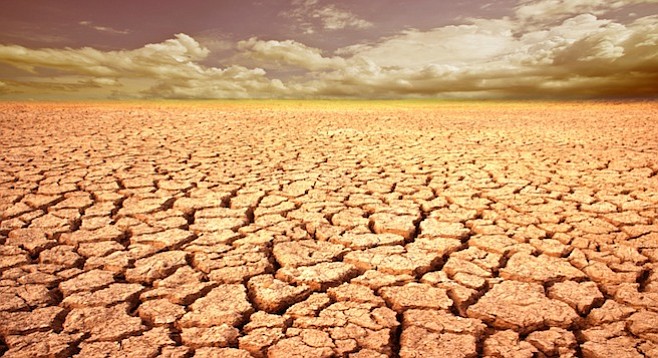 Facebook
Facebook
 X
X
 Instagram
Instagram
 TikTok
TikTok
 Youtube
Youtube

Yesterday (April 1), Governor Jerry Brown imposed statewide mandatory water restrictions for the first time in history. He wants California's water use slashed by 25 percent. He read off some horrifying statistics: the state's snowpack is 5 percent of normal. In January of last year, Brown wanted water usage to drop 20 percent, but the state achieved only half that. From now on, college campuses, cemeteries, golf courses, etc. will have to use less water.
On the same day, a San Diego city councilman declared that a Mission Valley real estate development, including thousands of condos and apartments, a hotel, offices, and retailers could generate enough money to pay for a subsidized Chargers stadium. Did anybody ask if there would be enough water for the condos, apartments, hotel, offices, retailers — and stadium?
Meanwhile, the battle over One Paseo, a proposed 1.4 million-square foot Carmel Valley development (also condos, apartments, retailers, offices) — already approved by the city council — roared on. Courageous San Diegans are opposing this monstrosity — but their main argument is possible traffic jams, not water. In Los Angeles, there are plans for a huge development and football stadium in Inglewood, as well as more development downtown. Is anybody thinking about water?
Last fall, scientists from Cornell, the University of Arizona, and the United States Geological Survey published a study stating that because of global warming, the chances of the Southwestern United States experiencing a decade-long drought — are 50 percent. And the chance of a megadrought — one lasting up to 35 years — is 20 to 50 percent over the next century. And ponder this: among the most vulnerable metro areas, according to these scientists, is San Diego.
Yesterday's New York Times quoted Michael Oppenheimer, a climate scientist at Princeton. Said he, commenting on the California drought: "The drought is made up of two components: not enough rain and too much heat. The rain deficit isn't clearly connected to climate change, but the planetary warming has made it more likely that the weather will be hotter in California."
Said the Times, "Warmer temperatures worsen drought by causing more evaporation from reservoirs, rivers, and soil. Scientists say that the warming trend makes it highly likely that California and other parts of the Western United States will have more severe droughts in the future."
Yet, California's state bird remains the High-Rise Crane. Development is going on everywhere. Governor Brown's father, Gov. Pat Brown, wanted to attract people to California. Does his son feel that way? Still? How much scientific evidence does California need? How much evidence do the vulnerable cities, such as San Diego and Phoenix, need?
Isn't it time for some long-term thinking? It's nice to limit how much water one can get in a restaurant. But that is the proverbial drop in the bucket.


Yesterday (April 1), Governor Jerry Brown imposed statewide mandatory water restrictions for the first time in history. He wants California's water use slashed by 25 percent. He read off some horrifying statistics: the state's snowpack is 5 percent of normal. In January of last year, Brown wanted water usage to drop 20 percent, but the state achieved only half that. From now on, college campuses, cemeteries, golf courses, etc. will have to use less water.
On the same day, a San Diego city councilman declared that a Mission Valley real estate development, including thousands of condos and apartments, a hotel, offices, and retailers could generate enough money to pay for a subsidized Chargers stadium. Did anybody ask if there would be enough water for the condos, apartments, hotel, offices, retailers — and stadium?
Meanwhile, the battle over One Paseo, a proposed 1.4 million-square foot Carmel Valley development (also condos, apartments, retailers, offices) — already approved by the city council — roared on. Courageous San Diegans are opposing this monstrosity — but their main argument is possible traffic jams, not water. In Los Angeles, there are plans for a huge development and football stadium in Inglewood, as well as more development downtown. Is anybody thinking about water?
Last fall, scientists from Cornell, the University of Arizona, and the United States Geological Survey published a study stating that because of global warming, the chances of the Southwestern United States experiencing a decade-long drought — are 50 percent. And the chance of a megadrought — one lasting up to 35 years — is 20 to 50 percent over the next century. And ponder this: among the most vulnerable metro areas, according to these scientists, is San Diego.
Yesterday's New York Times quoted Michael Oppenheimer, a climate scientist at Princeton. Said he, commenting on the California drought: "The drought is made up of two components: not enough rain and too much heat. The rain deficit isn't clearly connected to climate change, but the planetary warming has made it more likely that the weather will be hotter in California."
Said the Times, "Warmer temperatures worsen drought by causing more evaporation from reservoirs, rivers, and soil. Scientists say that the warming trend makes it highly likely that California and other parts of the Western United States will have more severe droughts in the future."
Yet, California's state bird remains the High-Rise Crane. Development is going on everywhere. Governor Brown's father, Gov. Pat Brown, wanted to attract people to California. Does his son feel that way? Still? How much scientific evidence does California need? How much evidence do the vulnerable cities, such as San Diego and Phoenix, need?
Isn't it time for some long-term thinking? It's nice to limit how much water one can get in a restaurant. But that is the proverbial drop in the bucket.
Comments